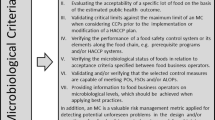Abstract
The most effective methods for virus detection in food and environmental samples are those based on nucleic acid amplification. Complex methods must be applied by the analyst in order to control for false negative results of virus detection assays in those samples that may be contaminated by virus concentrations above the detection level. The verification of analytical results is a necessity and this depends on using an appropriate suite of controls to monitor the efficacy of the critical steps in the method and allow correct result interpretations to be made. We describe the suite of controls necessary for analysing food and environmental samples for the presence of enteric viruses by nucleic acid amplification-based methods. To exclude false negative and positive interpretations of results, the inclusion of this suite of controls will be essential when considering incorporating monitoring of viruses in food or environmental safety management plans.

Similar content being viewed by others
References
Bosch, A., Sanchez, G., Abbaszadegan, M., Carducci, A., Guix, S., Le Guyader, F. S. Netshikweta, R., Pintó, R. M., van der Poel, W. H., Rutjes, S. A., Sano, D., Rodríguez-Lázaro, D., Kovac, K., Taylor, M. B., van Zyl, W., & Sellwood J. (2011). Analytical methods for virus detection in water and food. Food Analytical Methods, 4, 4–12.
Costafreda, M. I., Bosch, A., & Pintó, R. M. (2006). Development, evaluation, and standardization of a real-time TaqMan reverse transcription-PCR assay for quantification of hepatitis A virus in clinical and shellfish samples. Applied and Environmental Microbiology, 72, 3846–3855.
Croci, L., Dubois, E., Cook, N., De Medici, D., Schultz, A. C., China, B., et al. (2008). Current methods for extraction and concentration of enteric viruses from fresh fruit and vegetables: Towards international standards. Food Analytical Methods, 1, 73–84.
Hoorfar, J., Malorny, B., Abdulmawjood, A., Cook, N., Wagner, M., & Fach, P. (2004). Practical considerations in design of internal amplification controls for diagnostic PCR assays. Journal of Clinical Microbiology, 42, 1863–1868.
Rodríguez-Lázaro, D., D’Agostino, M., Pla, M., & Cook, N. (2004). Construction strategy for an internal amplification control for real-time diagnostic assays using nucleic acid sequence-based amplification: Development and clinical application. Journal of Clinical Microbiology, 42, 5832–5836.
Rodríguez-Lázaro, D., Lombard, B., Smith, H., Rzezutka, A., D’Agostino, M., Helmuth, R., et al. (2007). Trends in analytical methodology in food safety and quality: Monitoring microorganisms and genetically modified organisms. Trends in Food Science & Technology, 18, 306–319.
Rodríguez-Lázaro, D., Pla, M., Scortti, M., Monzó, H. J., & Vázquez-Boland, J. A. (2005). A novel real-time PCR for Listeria monocytogenes that monitors analytical performance via an internal amplification control. Applied and Environmental Microbiology, 71, 9008–9012.
Acknowledgments
This work was supported by the EU FP7 project ‘Integrated monitoring and control of foodborne viruses in European food supply chains (VITAL)’, Contract No. 213178. N.C. and M.D. acknowledge the support of the United Kingdom Food Standards Agency. We thank Dr. Marta Hernandez of ITACyL for preparation of the diagrammatic representation of the control suite.
Author information
Authors and Affiliations
Corresponding author
Rights and permissions
About this article
Cite this article
D’Agostino, M., Cook, N., Rodriguez-Lazaro, D. et al. Nucleic Acid Amplification-Based Methods for Detection of Enteric Viruses: Definition of Controls and Interpretation of Results. Food Environ Virol 3, 55–60 (2011). https://doi.org/10.1007/s12560-011-9063-8
Received:
Accepted:
Published:
Issue Date:
DOI: https://doi.org/10.1007/s12560-011-9063-8




